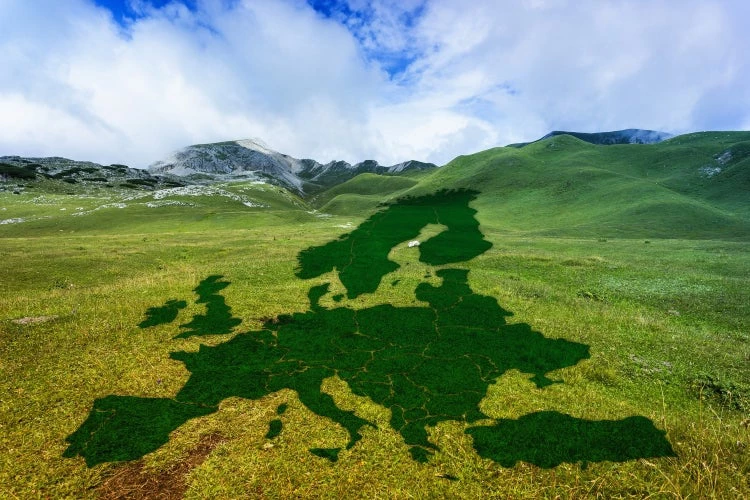European Union (EU) leaders agreed last month to mainstream climate action into policies and programs financed under the combined €1.8 trillion Multiannual Financial Framework and Next Generation EU recovery effort.
This is no bureaucratic blip: this Green Deal’s importance cannot be understated. Europe is the first power bloc to impose rigorous climate objectives and measures to achieve them. This will translate in societal changes and drive climate action policies forward elsewhere in the world. The EU will also soon propose ways to incentivize trading partners to come up with similar objectives and measures or risk restrictions or taxes—for example, the Border Carbon Adjustment that can be levied to ‘dirty’ exporters to the EU.
More than 20 years after the Kyoto Protocol introduced financial and behavior incentives to counter climate change, Europe’s Emission Trading Scheme is now the dominant carbon credit program. Simultaneously, technology, market conditions, and public perception continuously improve the commercial attractiveness of clean infrastructure solutions.
However, we need more—and quickly.
There are other ways to incentivize private investment to accelerate sustainable green infrastructure and here I argue that public-private partnerships (PPP) experience and thinking, sometimes from existing EU programs, can supplement proposed EU plans and achieve better outcomes.
In a world rightfully focused on COVID-19, the July agreement in Brussels is historic for its long-term vision and recognition that implementation largely will have to come from private actors. EU institutions’ role will focus on support and technical assistance as well as smart incentives. The European Investment Bank (EIB) will continue to be crucial, both as Europe’s prime development bank, and, like the World Bank, a thought leader on innovative financing and private sector participation.
The EIB will focus almost solely on sustainable green financing. They developed, with the European Commission and their Technical Expert Group on Sustainable Finance, a standardized taxonomy to classify sustainable assets and level impact—in addition to a Green Bond Standard expected to enter into force in 2021. For investors, this is an opportunity to achieve ESG targets and improve climate-related disclosures with a credible, easier-to-report bond.
Two new structures stand out: the InvestEU programme and the Just Transition Mechanism, both which have associated funds.
InvestEU builds on the previous Juncker Plan and is part of the Commission's mix of investment, structural reforms, and fiscal responsibility. InvestEU provides examples of incentives available to private actors including guarantees and loan facilities such as the Strategic Investment Facility. While eligibility is well-described, guarantees and facilities currently lack detail to target performance in a way familiar to PPPs and, therefore, are likely to be less efficient and open to moral hazard.
The Just Transition Mechanism (and Fund) will provide financial, technical, and advisory support for stakeholders in coal and other carbon-intensive regions in transitioning to ultra-low/zero carbon energy production. However, they do not include instruments to hedge long-term uncertainties around carbon emissions pricing or options to securitize future benefits to pay for investments.
More favorable financing, technical assistance, subsidies and the pricing and reduction of carbon credits are key incentives that can be strengthened by applying more innovative tools, such as:
- Guarantees that are available with many structures (and balance sheet implications) to address relevant risks. With PPPs, the EIB’s Project Bond Credit Enhancement is an example of a First Loss Portfolio Guarantee instrument. When employed properly and early in project structuring, unfortunately not always the case, this guarantee instrument could cover initial green project finance losses. Tools like the UK’s Woodland Carbon Guarantee instrument, which addresses investor concerns around the uncertain future price of a carbon reduction benefit (such as carbon storage). The instrument provides a British government floor price guarantee for carbon stored in planted trees until 2056. If/when the planter sells the credit, the carbon stored in the trees is worth more on the offset market than the government is obliged to pay, and it will be off the hook. If not, the government must to cough up. This incentivizes government to see that the value of carbon on such offset markets remains high. This guarantee structure can in theory be used for all sorts of investments that can long-term suck carbon out of the air and potentially also others where the value of long-term environmental benefits (or expected credits) can be monetized.
- Green Bond financial incentives that would increase investor attractiveness beyond ESG target achievement. In many countries green bonds come with tax benefits to the issuer or investor. The former may receive direct subsidies to lower costs and the latter would receive either tax credits, such as the U.S. federal government Clean Renewable Energy Bonds, or exemptions, such as in U.S. Municipal Bonds. Other measures could include compensation for accredited verification and guarantees covering specific risks (such as around project start-up/teething period).
- Boosts to investors’ confidence in long-term revenues and debt serviceability, which are always stimulating. PPPs have laid out the way with sophisticated contracts and payments mechanisms to address this. In addition to guarantees and bonds, hedging instruments—including insurance and diversification/extension of revenues—are understood by the market and popular. For example, Canadian Pension Fund CDPQ is investing in Montreal’s new light rail system with public co-investors and a right to commercialize last-mile transit solutions and link stations to the fund’s commercial area development branch. Packaging EV charging systems in wider transit solutions may well improve the overall project’s financial viability.
With the major steps the EU is making on climate action, we must think harder and share experiences about how other financial instruments can push achievement of the Paris Agreement objectives. Decades of global PPP thinking can be an excellent starting point.
Related Posts
We need to act now for sustainable infrastructure investments
Green Bonds: From evolution to revolution
What’s next for ESG and investment decisions?
Latin American green bonds are resurging
This blog is managed by the Infrastructure Finance, PPPs & Guarantees Group of the World Bank. Learn more about our work here.



Join the Conversation